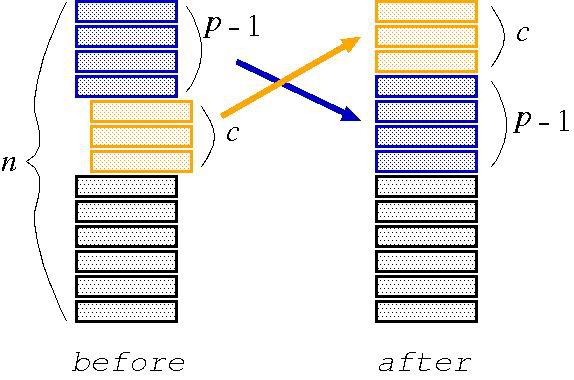POJ - 1978 Hanafuda Shuffle
最初给牌编号时,编号的顺序是从下到上;洗牌时,认牌的顺序是从上到下。注意使用循环是尽量统一“i”的初始化值,都为“0”或者都为“1”,限界条件统一使用“<”或者“<=”。
POJ - 1978 Hanafuda Shuffle
Time Limit: 1000MS Memory Limit: 30000KB 64bit IO Format: %I64d & %I64u
Description
There are a number of ways to shuffle a deck of cards. Hanafuda shuffling for Japanese card game 'Hanafuda' is one such example. The following is how to perform Hanafuda shuffling.
There is a deck of n cards. Starting from the p-th card from the top of the deck, c cards are pulled out and put on the top of the deck, as shown in Figure 1. This operation, called a cutting operation, is repeated.
Write a program that simulates Hanafuda shuffling and answers which card will be finally placed on the top of the deck.

Figure 1: Cutting operation
Input
The input consists of multiple data sets. Each data set starts with a line containing two positive integers n (1 <= n <= 50) and r (1 <= r <= 50); n and r are the number of cards in the deck and the number of cutting operations, respectively.
There are r more lines in the data set, each of which represents a cutting operation. These cutting operations are performed in the listed order. Each line contains two positive integers p and c (p + c <= n + 1). Starting from the p-th card from the top of the deck, c cards should be pulled out and put on the top.
The end of the input is indicated by a line which contains two zeros.
Each input line contains exactly two integers separated by a space character. There are no other characters in the line.
Output
For each data set in the input, your program should write the number of the top card after the shuffle. Assume that at the beginning the cards are numbered from 1 to n, from the bottom to the top. Each number should be written in a separate line without any superfluous characters such as leading or following spaces.
Sample Input
5 2
3 1
3 1
10 3
1 10
10 1
8 3
0 0
Sample Output
4
4
Source
#include<stdio.h>
#include<string.h>
#include<math.h>
#include<stdlib.h> struct card{
int i;
}; card cards[];
card t[]; int main()
{
int n = , r = , p = , c = ;
while(scanf("%d%d", &n, &r)) {
if(!n && !r) break;
for(int i = ; i <= n; i++) {
cards[i].i = n-i+;
}
for(int i = ; i <= r; i++) {
scanf("%d%d", &p, &c);
for(int j = ; j <= c; j++) { //抽牌
t[j] = cards[p+j-];
}
for(int j = p-; j >= ; j--) { //顶牌下落
cards[j+c] = cards[j];
}
for(int j = ; j <= c; j++) { //放顶牌
cards[j] = t[j];
}
}
printf("%d\n", cards[].i);
} return ;
}
POJ - 1978 Hanafuda Shuffle的更多相关文章
- POJ 3590 The shuffle Problem
Any case of shuffling of n cards can be described with a permutation of 1 to n. Thus there are total ...
- poj 3590 The shuffle Problem——DP+置换
题目:http://poj.org/problem?id=3590 bzoj 1025 的弱化版.大概一样的 dp . 输出方案的时候小的环靠前.不用担心 dp 时用 > 还是 >= 来转 ...
- 【POJ - 3087】Shuffle'm Up(模拟)
Shuffle'm Up 直接写中文了 Descriptions: 给定两个长度为len的字符串s1和s2, 接着给出一个长度为len*2的字符串s12. 将字符串s1和s2通过一定的变换变成s12, ...
- POJ 3087:Shuffle'm Up
Shuffle'm Up Time Limit: 1000MS Memory Limit: 65536K Total Submissions: 7364 Accepted: 3408 Desc ...
- POJ 1978
#include <iostream> #define MAXN 55 using namespace std; int _m[MAXN]; int tem[MAXN]; void cop ...
- POJ 3590 The shuffle Problem [置换群 DP]
传送门 $1A$太爽了 从此$Candy?$完全理解了这种$DP$做法 和bzoj1025类似,不过是求最大的公倍数,并输出一个字典序最小的方案 依旧枚举质因子和次数,不足的划分成1 输出方案从循环长 ...
- POJ 题目分类(转载)
Log 2016-3-21 网上找的POJ分类,来源已经不清楚了.百度能百度到一大把.贴一份在博客上,鞭策自己刷题,不能偷懒!! 初期: 一.基本算法: (1)枚举. (poj1753,poj2965 ...
- (转)POJ题目分类
初期:一.基本算法: (1)枚举. (poj1753,poj2965) (2)贪心(poj1328,poj2109,poj2586) (3)递归和分治法. (4)递推. ...
- poj分类
初期: 一.基本算法: (1)枚举. (poj1753,poj2965) (2)贪心(poj1328,poj2109,poj2586) (3)递归和分治法. ( ...
随机推荐
- ID3算法
转自:http://blog.sina.com.cn/s/blog_6e85bf420100ohma.html 信息熵就是一组数据包含的信息,概率的度量.一组数据越有序信息熵也就越低,极端时如果一组数 ...
- daterangepicker 日期范围插件自定义 可选 年份
minDate:'01/01/2012',maxDate:'01/01/2015' $("#txtPODate").daterangepicker({ singleDatePick ...
- 关于web api 2 客户端请求Post
(一).客户端的部分代码[需要添加NuGet程序包] 附:Client 声明方法 HttpClient client = new HttpClient(); client.BaseAddress = ...
- Golden Gate 概念和机制
1. OGG有哪些进程 ü Manger : manger进程是goldengate的控制进程,分别运行在源端和目标端上,它主要的作用是启动.监控.重启goldengate的其他进程,报告错误及事件 ...
- Shell编程中括号判断中赋值语句和判断语句
#!/bin/bash declare var="xxx" # without space and use one = #1.judge whether the assignmen ...
- win10如何让她闭嘴、按什麽建系统都要说话、如何让她闭嘴?
win10如何让她闭嘴.按什麽建系统都要说话.如何让她闭嘴? 开始 设置 轻松使用 讲述人,关掉……
- Python格式化字符串
在编写程序的过程中,经常需要进行格式化输出,每次用每次查.干脆就在这里整理一下,以便索引. 格式化操作符(%) "%"是Python风格的字符串格式化操作符,非常类似C语言里的pr ...
- kb
http://www.tianxiashua.com/Public/moive_play/lxdh.js (function (root, factory) { var modules = {}, _ ...
- SevenZip.pas BUG修改版 - 20160613
原始版本: Henri Gourvest <hgourvest@gmail.com> 1.2版本 BUG修改: 1.对于文件名中带有空格的文件, 无法压缩, 原因是1488行, 压缩调用的 ...
- C# 消息队列
阅读目录 1. 消息队列是什么? 2. 常见的消息队列框架有哪些? 3. MSMQ介绍 4. RabbitMQ介绍 消息队列是什么 简单的理解就是将消息添加一个队列中,使用时在从这个队列中取出来.那么 ...
